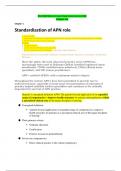Summary
Summary Consumer Behavior - Lecture & Article Summaries
- Course
- Institution
Please note that while these notes do follow the Lecture & Tutorial Schedule, they have been moved up and down in certain areas to ensure clarity. It is designed to help understand the concept as well as answer questions that may pop up in the exam. Some parts may be more concise than you expect.
[Show more]












